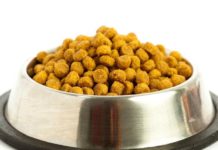
Knowing what to feed a dog is frustrating, complicated and, in a word, a headache! On one hand you have the people that stand firmly behind the commercial food manufacturers because of the long-standing success the animal world has seen in the overall improvement in the health, lifespan and condition of our four-legged friends since the inception of commercial diets. On the other hand you have the RAW food/BARF diet/make you own dog food camp that feel ‘kibble kills’ and taking our pets back to their nutritional origin is the only way to return the breeds back to health.
Convenience in a Bag
The ‘inception of commercial diets’ might be an exaggeration as commercial diets have undergone their fair share of growing pains. The first of these mass produced foods where little more then semi-formed bricks similar to a heavy muffin or loaf made from wheat, meat by-products with maybe a few vegetables tossed in. Although the consistency and overall quality of the product was questionable, the convenience factor soon won over the general public and the commercial dog food manufacturing process rapidly developed into a mainstay of pet owners everywhere. Commercial dog food is no longer a hit or miss product but one that the high end manufacturers have spent years researching and performing trials to hone into a healthy, consistent and tasty choice with formulas specialized for all stages of life as well as many medical conditions.
Back in the Kitchen to Cook up some Chow
There are many homemade diet recipes available and all have their merits and solid arguments with the most important being that when you make the food yourself, you know exactly what goes into it. After the massive recall of commercial food in 2007 from melamine contamination, that argument is a much stronger one then ever before. There are as many recipes for homemade diets as there are breeds of dogs but which is right for your dog takes a bit of trial and error. Most of these diets include meat, vegetables and a complex carbohydrate so the nutritional balance is more or less correct and they should not be deficient in any nutrients. The good part of a homemade diet is it is easy to adjust as requirements change i.e. if your dog develops a bad case of diarrhea take out the richer meats such as lamb or organ meats and increase the rice content until the stomach has settled.
Cooking? Who Needs Cooking?
A Raw diet and BARF (Bones and Raw Food) are just like they sound – all food, including the meat, is served uncooked hence the name. Raw food advocates stress that this diet is as close to what wild dogs would have eaten before man stepped in and that it will clear up many diseases that plague our pets today.
However, the jury is out on the safety of this diet for a number of reasons. The first and least important is that aggression and food guarding behavior has been seen in many dogs when fed raw chicken backs and bones. This is manageable as all that is needed is extra caution and training to resolve the issue.
The second problem is whether feeding of raw bones is safe. Raw bones are not as dangerous as cooked bones but they can lead to bowel impaction or blockages. There have also been a handful of cases of bone fragments slicing through the intestinal wall. In one case several years ago in Victoria, BC Canada, the fragment then nicked an artery and the two year old Golden Retriever bled to death internally before the vet could stop the bleeding. This is a rare occurrence and the likelihood of anything similar happening is slim but caution should be taken when considering switching your dog to a raw or BARF diet.
The last concern is to watch the levels of bones, meat, vegetables and grains (if used). Some BARF diets advocate as much as 60% of the dog’s caloric intake to come from bones. Almost 95% of the organic material (a third of the total components of bone) is collagen, a fibrous protein that neither cats nor dogs digest well and the high levels of calcium and phosphorous that are an integral part of the inorganic hydroxyapatite crystals that form the framework of all bones and account for other two thirds of the total components. Suffice it to say that bones comprising nearly 60% of a dog’s nutritional intake is too much and as for the fatty marrow inside of the large bones, it is just that – a fatty substance with little nutritional content unless a high concentration of fat is required. The idea that wild dogs eat the bones of prey is not altogether true. When a wild dog or wolf makes a kill like a deer for example, the first part they eat is the viscera leading researchers to believe that the partially digested ‘greens’ as well as the digestive enzymes are the most important part of the meal. The next to go are the organs, then the meat and finally the bones. The bones are mostly split to gain access to the marrow as wild dogs and wolves have a greater need for fat then our domestic canines.
So What is the Answer?
The simple answer is to feed your dog the best quality food that fits your lifestyle. If kibble is your idea of heaven, make sure that you are buying high quality food that meets your dog’s nutritional needs. If it is important for you to know exactly what your dog is eating and you have a little extra time on your hands, then, under the guidance of your veterinarian, a homemade diet is a great solution. A well-planned Raw or BARF diet is an excellent solution for animals with allergies, immune-mediated diseases and many other disorders but with a note of caution regarding the use and quantity of raw bones.
Undecided? Try a combination of the above – kibble mixed with a homemade ‘stew’, whether it is raw or cooked, blend nicely together to provide both balanced nutrition and whole real foods. For many, it’s the best of all worlds and guarantees a well-rounded canine!





